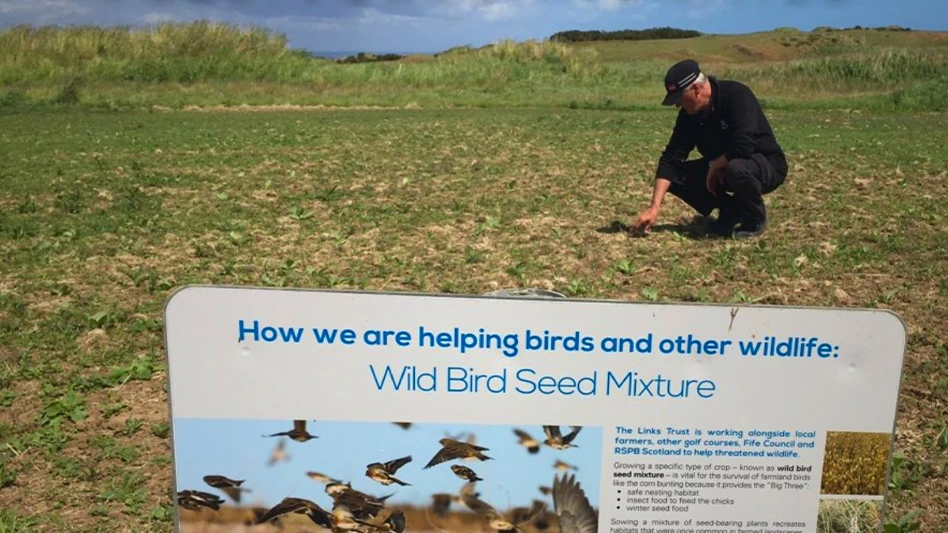Summer Screams
 The heat just wouldn't let up at Cypress Bend Resort, leaving the course and hotel with fewer customers interested in sticking around. A drought wracked the nearby city of Toledo Bend, so of course, the course owners set up a 700-foot slip and slide on the driving range and let the kids have fun on the turf for a day.
The heat just wouldn't let up at Cypress Bend Resort, leaving the course and hotel with fewer customers interested in sticking around. A drought wracked the nearby city of Toledo Bend, so of course, the course owners set up a 700-foot slip and slide on the driving range and let the kids have fun on the turf for a day.
That's what they thought the obvious answer was, anyway.
"This area is so devastated by drought, we wanted to think of something to get people and get their spirits up. That was our biggest concern here," says Jeb Smith, superintendent.
Between the concept to the event was only about 11 days, giving Smith a short time to work together an irrigation system that could provide plenty of cool, refreshing water without being a constant reminder to local residents of the course's usage in a citywide drought — especially for a non-golf event.
He got to work with a local irrigation company that had handled large water slides before, and went out for parts. He orchestrated a low-misting system, fed by a 1-inch pipe down to half-inch poly pipes to keep the pressure even throughout the slide.
Even though the course's water came from a separate source than the city and wasn't being restricted, the resort didn't want to even give the impression that they were being irresponsible with water. Besides the low-misting system, they launched a social media and news campaign to not only drum up interest but to bring attention to the low-volume irrigation system.
"I told him about the event and said, 'We need a lot of water for this, but we can't make it look like we're using any,'" says Kerry Bennett, general manager of the resort.
Smith was out at 4:30 a.m., finishing the preparations for the slide around 10 a.m. on the 107 degree day, opening the floodgates for about 200 local kids and their families.
"I was really impressed with the turnout," says Bennett. "The system worked great. After they had gone on the slide, they would be leaving and say, 'Hey, where was all the water? I didn't even see it.'"
The Cypress Screamer brought in new people and more importantly, business. There were rooms booked at the resort during the event, and the local community got a chance to see the golf course in a way that some hadn't before: just a fun place to be.
 "The kids absolutely loved it," says Smith. "Most of the people I saw out here were people that don't normally come out to the course. You never know, you're liable to get a member out of something like this."
"The kids absolutely loved it," says Smith. "Most of the people I saw out here were people that don't normally come out to the course. You never know, you're liable to get a member out of something like this."
All the action didn't even damage the turf, as the crew pulled up the slide as soon as the day was done, and the low-volume mist kept water from pooling, as well.
Even so, they're planning on changing the location next year. Not for the turf's sake, but because a much steeper slope along the driving range is calling, and it's not called the Cypress Screamer for nothing.
Need to cool off?
Check out the Cypress Screamer in action, including a helmet-cam view at http://bit.ly/n4Pkg3.
Rued roos’ rude ruse
It's no joke: some hungry hoppers have left Meadow Springs Golf and Country Club in Perth, Australia, without much spring in its step. According to superintendent Greg Simmonds, the local kangaroos eat away at the course's turf, picking on the new growth of the understory and leaving behind acres full of weeds and plenty of their own natural waste.
The course is meant to preserve the natural look of the bushland before development, according to Simmonds, but the kangaroos seem to be more excited about a preserved area full of turf and native grass for snacking. He says the roos' noshing will change the ecosystem of the area, with more than 50 acres of the course already cleared this season. And with a recent count at more than 200 local kangaroos, maybe he'd be better off opening a boxing gym.
A Community Effort
Heavy winds tore through Meadow Lake Golf Course in Saskatchwan one evening in the middle of July. Superintendent Daryl Wood inspected the course the next morning, prepared to find debris and for a day of cleanup. But what he found looked more like a war zone, he says.
The storm had demolished the trees of the front nine holes of the course. Every single hole either had damaged trees or completely toppled across the course.
"The front nine were pretty much covered. A lot of our main trees were just down along the course," he says.
After gathering his five-man crew, they started work on the damaged course, just trying to move and clear away what they could. But then, someone on his team got in contact with a local logging company, whose crews were unable to get to their regular work because of the storm. They came out to help, and word spread that the course had been devastated. Course members, local residents and even businesses started turning up to help.
Some sawed through trunks and cleared away brush, while others provided equipment and even others provided food from town to keep the volunteers going. All in all, the volunteers gave about 750 hours of labor to clear the debris and created a giant wood pile, something Wood's crew never could've accomplished on their own that day.
"This is a place where everybody knows everybody, and we help each other out," he says. "Without that volunteer effort, we would've had no chance at dealing with that."

Explore the September 2011 Issue
Check out more from this issue and find your next story to read.
Latest from Golf Course Industry
- Making the grade — at or near grade
- PBI-Gordon receives local business honor
- Florida's Windsor takes environmental step
- GCSAA names Grassroots Ambassador Leadership Award winners
- Turf & Soil Diagnostics promotes Duane Otto to president
- Reel Turf Techs: Ben Herberger
- Brian Costello elected ASGCA president
- The Aquatrols Company story





